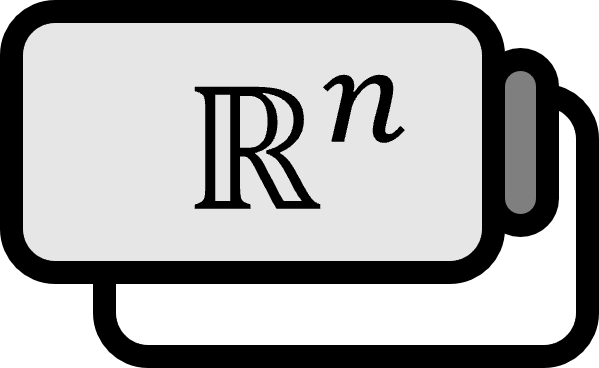n-Dimensional Polar Coordinates
Definition1
Let’s say the Cartesian coordinates of point $x \in \mathbb{R}^{n}$ are $x_{1}, \dots, x_{n}$. Then, the relationship with its polar coordinates $r, \varphi_{1}, \dots, \varphi_{n-1}$ is as follows.
$$ \begin{align*} x_{n} &= r \cos \varphi_{1} \\ x_{n-1} &= r \sin \varphi_{1} \sin \varphi_{2} \\ x_{n-2} &= r \sin \varphi_{1} \cos \varphi_{2} \\ \vdots& \\ x_{4} &= r \sin \varphi_{1} \sin \varphi_{2} \cdots \sin \varphi_{n-3} \sin \varphi_{n-2} \\ x_{3} &= r \sin \varphi_{1} \sin \varphi_{2} \cdots \sin \varphi_{n-3} \cos \varphi_{n-2} \\ x_{2} &= r \sin \varphi_{1} \sin \varphi_{2} \cdots \sin \varphi_{n-2} \sin \varphi_{n-1} \\ x_{1} &= r \sin \varphi_{1} \sin \varphi_{2} \cdots \sin \varphi_{n-2} \cos \varphi_{n-1} \\ \end{align*} $$
Here,
$$ 0 \le \varphi_{i} \le \pi \ (1 \le i \le n-2), \quad 0 \le \varphi_{n-1} \le 2\pi $$
Explanation
The formula mentioned above can be confusing, but first, you set $x_{n}$ as $r\cos\varphi_{1}$ and take the other values according to the formula for $x_{1}, x_{2}, \dots$ from below. For more detail, see the example below. It explains that in two dimensions, it’s called polar coordinates, and in three dimensions, it’s called spherical coordinates, but you don’t have to call them that way. Physics typically does not deal with dimensions beyond $n$, so this distinction is important, and the names actually signify the 2D and 3D nature. However, in mathematics, the terms polar coordinates or spherical coordinates feel much less restricted by dimension. It seems like a matter of preference how one uses them.
$n=2$
This case is particularly referred to as polar coordinates, commonly denoted by $\theta = \varphi_{1}$. Then $x_{2}$ is
$$ x_{2} = x_{n} = r \cos \varphi_{1} = r \cos \theta $$
$x_{1}$, when substituting $n=2$, becomes
$$ x_{1} = r \sin \varphi_{1} \cdots \sin \varphi_{n-2} \cos \varphi_{n-1} = r \sin \varphi_{1} = r \sin \theta $$
Therefore,
$$ \begin{align*} x_{2} &= y = r \cos \theta \\ x_{1} &= x = r \sin \theta \\ \end{align*} $$
$$ \left| \mathbf{x} \right| = r^{2} \cos^{2}\theta + r^{2} \sin^{2}\theta = r^{2} = \left| \mathbf{r} \right| $$
$n=3$
This case is particularly referred to as spherical coordinates, commonly expressed by $\theta = \varphi_{1}$, $\phi = \varphi_{2}$. $x_{3}$ is
$$ x_{3} = x_{n} = r \cos \varphi_{1} = r \cos \theta $$
$x_{2}$, when substituting $n=3$, becomes
$$ x_{2} = r \sin \varphi_{1} \cdots \sin \varphi_{n-2} \sin \varphi_{n-1} = r \sin \varphi_{1} \sin \varphi_{2} = r \sin \theta \sin \varphi $$
$x_{1}$, when substituting $n=3$, becomes
$$ x_{1} = r \sin \varphi_{1} \cdots \sin \varphi_{n-2} \cos \varphi_{n-1} = r \sin \varphi_{1} \cos \varphi_{2} = r \sin \theta \cos \varphi $$

Therefore,
$$ \begin{align*} x_{3} &= z= r \cos \theta \\ x_{2} &= y= r \sin \theta \sin \varphi \\ x_{1} &= x= r \sin \theta \cos \varphi \end{align*} $$
$$ \begin{align*} \left| \mathbf{x} \right| = x_{1}^{2} + x_{2}^{2} + x_{3}^{2} &= r^{2}\sin^{2}\theta\cos^{2}\varphi + r^{2}\sin^{2}\theta\sin^{2}\varphi + r^{2}\cos^{2}\theta \\ &= r^{2}\sin^{2}\theta + r^{2}\cos^{2}\theta \\ &= r^{2} \\ &= \left| \mathbf{r} \right| \end{align*} $$
$n=4$
Let’s just go up to $n=4$. $x_{4}$ is,
$$ x_{4} = x_{n} = r \cos \varphi_{1} $$
$x_{3}$, when substituting $n=4$, becomes
$$ x_{3} = r \sin \varphi_{1} \cdots \sin \varphi_{n-3} \cos \varphi_{n-2} = r \sin \varphi_{1} \cos \varphi_{2} $$
$x_{2}$, when substituting $n=4$, becomes
$$ x_{2} = r \sin \varphi_{1} \cdots \sin \varphi_{n-2} \sin \varphi_{n-1} = r \sin \varphi_{1} \sin \varphi_{2} \sin \varphi_{3} $$
$x_{1}$, when substituting $n=4$, becomes
$$ x_{1} = r \sin \varphi_{1} \cdots \sin \varphi_{n-2} \cos \varphi_{n-1} = r \sin \varphi_{1} \sin \varphi_{2} \cos \varphi_{3} $$
Therefore,
$$ \begin{align*} x_{4} &= r \cos \varphi_{1} \\ x_{3} &= r \sin \varphi_{1} \cos \varphi_{2} \\ x_{2} &= r \sin \varphi_{1} \sin \varphi_{2} \sin \varphi_{3} \\ x_{1} &= r \sin \varphi_{1} \sin \varphi_{2} \cos \varphi_{3} \end{align*} $$
$$ \begin{align*} \left| \mathbf{x} \right| &= x_{1}^{2} + x_{2}^{2} + x_{3}^{2} + x_{4}^{2} \\ &= (r \sin \varphi_{1} \sin \varphi_{2} \cos \varphi_{3}) + r \sin \varphi_{1} \sin \varphi_{2} \sin \varphi_{3}\\ &= (r^{2} \sin^{2} \varphi_{1} \sin^{2} \varphi_{2} \cos^{2} \varphi_{3}) + (r^{2} \sin^{2} \varphi_{1} \sin^{2} \varphi_{2} \sin^{2} \varphi_{3}) + (r^{2} \sin^{2} \varphi_{1} \cos^{2} \varphi_{2}) + (r^{2} \cos^{2} \varphi_{1}) \\ &= (r^{2} \sin^{2} \varphi_{1} \sin^{2} \varphi_{2}) + (r^{2} \sin^{2} \varphi_{1} \cos^{2} \varphi_{2}) + (r^{2} \cos^{2} \varphi_{1}) \\ &= (r^{2} \sin^{2} \varphi_{1}) + (r^{2} \cos^{2} \varphi_{1}) \\ &= r^{2} \\ &= \left| \mathbf{r} \right| \end{align*} $$
$x \ne 0$ allows us to obtain the following.
$$ \boldsymbol{\theta} = \dfrac{x}{\left| x \right|} \in S^{n-1}, \quad x = r\boldsymbol{\theta},\quad r = \left| x \right| > 0 $$
Note that $\boldsymbol{\theta}$ here is not an angle. The Cartesian coordinates $\theta_{1}, \dots, \theta_{n}$ are expressed by the following formula.
$$ \cos \varphi_{k-1} = \dfrac{\theta_{k}}{r_{k}}, \quad \sin \varphi_{k-1} = \frac{r_{k-1}}{r_{k-2}},\quad r_{k} = \left( \theta_{1}^{2}, \dots, \theta_{k}^{2} \right)^{1/2} $$
Furthermore, the mapping from $\mathbb{R}^{n} \setminus \left\{ 0 \right\}$ to $\mathbb{R}_{+} \times S^{n-1}$ $x \mapsto (r, \boldsymbol{\theta})$ is continuous and bijective.
Properties
The following integral holds. For $f \in L^{1}(\mathbb{R}^{n})$,
$$ \int_{\mathbb{R}^{x}} f(x) dx = \int\limits_{S^{n-1}} \int\limits_{0}^{\infty} f(r \boldsymbol{\theta}) r ^{n-1}dr d\boldsymbol{\theta} $$
Boris Rubin, Introduction to Radon Transforms With Elements of Fractional Calculus and Harmonic Analysis (2015), p26-27 ↩︎
